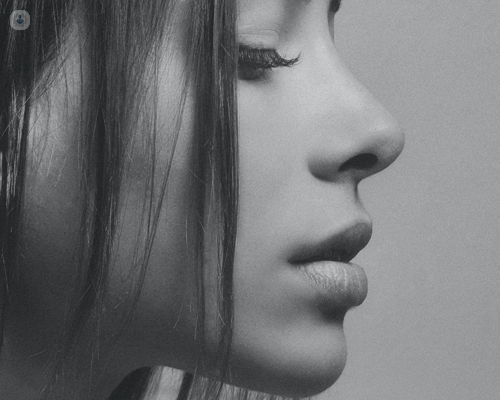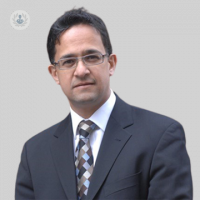Open vs closed rhinoplasty: which is better for me?
Written by:Rhinoplasty, also commonly called a nose job, is a procedure that is undertaken to change the shape and size of the nose. It can either be performed as an open or closed surgery. What is the difference and how is the most suitable option chosen? Esteemed consultant plastic and craniofacial surgeon Mr Jonathan Britto, who treats patients in London and Essex answers some of the most frequently asked questions about the two types of rhinoplasties.

What is the difference between an open rhinoplasty and a closed rhinoplasty?
Often, I am asked about the difference between open and closed rhinoplasties. The most important thing is choosing the technique that will satisfy the need or reason for rhinoplasty surgery. It should be discussed with the patient, so they understand what's going to happen.
Open rhinoplasty allows exposure of the nose’s framework so that we can see every level of the nose open on the operating table. The visible scar is across the columella (the part between your nostrils) and the rest of the scarring is inside the nostril. With a closed rhinoplasty, the scarring is inside the nostril and there's no visible scar across the columella.
However, scarring from open rhinoplasty is very minimal, so the benefits of open and closed rhinoplasty should not be considered related to the visibility of the scar; they should be considered in the assessment of what is to be achieved by that rhinoplasty and whether or not the open technique or the closed technique can achieve those aim. Broadly speaking, because it does not elevate the soft tissue envelope of the nose, a closed rhinoplasty is considered to be less prone to swelling and delivers a faster result. However, open rhinoplasty gives the surgeon a tremendous amount of flexibility in dealing with all levels of the nose and is often a better approach simply for that reason.
Is closed rhinoplasty safer?
Patients commonly ask whether closed rhinoplasty is a safer procedure than open rhinoplasty and to be honest, it is not. Open rhinoplasty, if done properly, should be as safe as closed rhinoplasty. Each has its potential risks, healing time, and long-term outcome. Choosing between an open rhinoplasty and a closed rhinoplasty should be about the final result "which technique is my surgeon more confident with, to get me to where I want to be?”.
Which factors determine whether an open or closed rhinoplasty is better for me? How are the results different and will these be long-lasting?
The factors determining whether an open and closed rhinoplasty is more suitable relate to what needs to be done technically within the nose. Most rhinoplasties involve some form of framework change. This framework is made up of the bony part of the nose, the bony cartilaginous junction, and the tip structures, which are mostly cartilaginous. Each of those levels can be managed either by open or closed rhinoplasty, but it depends on various factors. For example, how much manipulation of those tissues is required and whether or not the surgeon feels that they will be able to get the shape of those structures to where you need it to be to deliver the desired result.
Given the level of complexity required to achieve the final result, most surgeons tend to shift towards an open approach, where the tissues can be very easily seen, manipulated, reshaped, and fixed on with full visibility.
How visible is the scar in an open rhinoplasty?
In most cases, the external scars of open rhinoplasty are usually incredibly forgiving and are one of the most minimal of any appearance-changing facial surgery.
The scar from open rhinoplasty runs across the columella, the midline strut of the nose, and different surgeons use different techniques to break up that scar to make it less obvious, such as Z-plasy or V-plasty procedures. The remainder of that scar lies around the perimeter of the nostril internally.
Sometimes, we will use external scars high up in the perimeter of the nose in the tear trough between the junction of the lower eyelid in the nose. These are tiny pinprick scars, which heal beautifully, and can be used to perform an osteotomy, to tease the bone into the right shape.
How long should I expect my rhinoplasty recovery to be?
Patients frequently enquire about the recovery time from a rhinoplasty. Firstly, there's the immediate recovery, about fourteen days to a couple of weeks, which will require time off work. By the time patients go back to work, the cast will be off the nose, there will be a nasal shape change, but there will be visible swelling. There might even be some bruising around the lower eyelid, but with modern techniques of piezo (ultrasound) rhinoplasty, even that bruising is minimal.
After this stage, the long-term recovery is dependent. I like to tell patients: at two weeks somebody who knows us marginally well will not notice, but your close friends and relatives will know that there's some swelling in the nose. Usually by six to twelve weeks, even close family will not be able to tell that there has been any swelling in the nose or a procedure undertaken. By six months to a year, the patient themselves, who are very intimate with their own nose, will have sensation back in the tip of the nose and the framework definition will have emerged.
Immediate recovery, until the cast comes off and the swelling and bruising is still evident, will take about two-to-three weeks. Medium term recovery is three months, and final definition of the recovered nose will be apparent after one year.
Mr Jonathan Britto MB MD FRCS(Plast) is a leading consultant plastic surgeon based in London and Essex. If you are interested in booking a consultation with him, you can do so by visiting his Top Doctors profile today.


